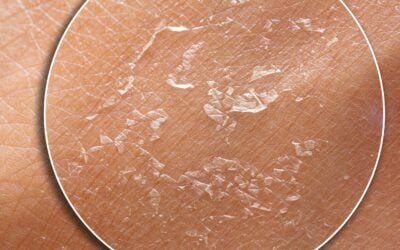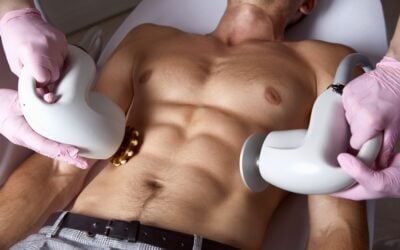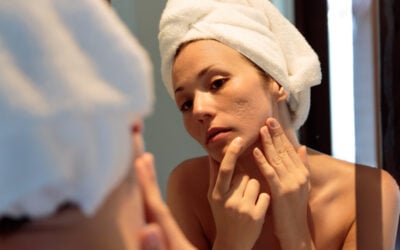
How many times have you seen an old high school classmate and thought, “Wait, that’s not fair! Why doesn’t she have these lines across her forehead, and why can’t I look that young?”
The truth is that your smooth-faced peers are capable of getting the same creases and lines as you have, but they probably have a great skincare routine that keeps those wrinkles at bay. Or—and it’s very likely, if they don’t have any lines across their forehead—they get regular professional treatments to eliminate forehead wrinkles. The great news is that if you want to feel younger and age just as gracefully, those same options are available to you!
What causes forehead wrinkles?
As frustrating as they are, forehead wrinkles are part of the natural aging process. Light creases and fine lines can start to form on the forehead in our late 20’s, but they become more noticeable in our late 30s and 40s as skin becomes thinner and loses collagen and elastin, which keep the skin firm and tight.
Just how severe your forehead wrinkles are depends on a number of factors. If your mom or dad have deep forehead lines, you’re likely to have them too. If you spent a lot of time in the sun growing up and in your 20s, those UV rays may have sped up the breakdown of collagen and elastin.
Being very expressive with your emotions—i.e. raising your eyebrows a lot when telling a great story or frowning when perplexed—can also make wrinkles form on your forehead over time. At first, they appear when your facial muscles are moving (known as dynamic wrinkles), but eventually they can stay there even when you’re not making any expressions (these are called static wrinkles).
How to get rid of forehead wrinkles at home
Just like extra pounds pile on as metabolism slows down with age, wrinkles form due to a decrease in elastin and collagen as we grow older. And just like using weights can help boost your metabolism to lose weight, using the right skin care products can help boost collagen and elastin production to reduce wrinkles.
Here are some of the best wrinkle-reducing ingredients to incorporate into your skin care routine.
Hyaluronic acid. It attracts and retains water molecules to hydrate and plump the skin, helping to smooth fine lines and wrinkles. Since it’s applied topically in serums and moisturizers, it doesn’t stimulate the actual production of collagen and elastin. However, it can temporarily reduce the appearance of forehead lines when used consistently.
Vitamin C. The air all around us has lots of contaminants like cigarette smoke, chemical pollution, and heavy metals that damage skin and cause wrinkles. Vitamin C is an antioxidant that protects the skin from these free radicals, helping to prevent the collagen loss they cause. Using a Vitamin C serum can improve overall skin tone and enhance skin elasticity and firmness.
Peptides. Peptides are amino acids that stimulate collagen and elastin production, improve skin elasticity and firmness, enhance hydration, and promote a more even skin tone and texture. Look for a serum that contains Matrixyl (Palmitoyl Pentapeptide-4), which stimulates collagen production, and Argireline (Acetyl Hexapeptide-8), known to improve the appearance of fine lines and wrinkles.
Retinol. Retinol exfoliates the skin to encourage new skin-cell and collagen production, which can reduce the appearance of forehead wrinkles. Since retinol becomes deactivated by sunlight, it should be applied at night as a moisturizer so it can work while you sleep. When used alone, it can dry and irritate some skin types, so it’s a good idea to look for products that also contain hyaluronic acid. You should notice fewer lines and smoother skin after three months of use.
Sunscreen. Since UV rays speed up the breakdown of collagen and elastin, you should apply sunscreen every morning — even when spending time indoors since sunshine can stream in through windows. Look for an SPF of 30 or higher, and put it on after serum and moisturizer.
Professional solutions to eliminate forehead wrinkles
While the right skin care routine can definitely minimize creases and fine lines, there’s only so much that topical creams can do. By getting rid of the top layer of damaged skin or injecting solutions that plump the skin from the inside, it’s more likely that you’ll see faster results that last longer.
There are several procedures that Forefront providers recommend when patients ask how they can eliminate forehead wrinkles.
Microneedling. Just as the name sounds, microneedling uses tiny needles to puncture the skin, which stimulates growth of new collagen and elastin. This works best for fine, shallow lines in the forehead. There are different variations of microneedling, such as collagen PIN microneedling, which uses an automated process to create controlled micro-injuries to the skin and forms micro-channels where topical serums and creams are absorbed more effectively.
Neurotoxins. When muscles move over time, they get bigger. After many years of showing surprise or frowning, the muscles used to make those expressions become more prominent, and the skin around them forms wrinkles. Injectable neurotoxins work by relaxing those muscles, which in turn smooths the skin around them. Botox is the most well-known neurotoxin, but other products like Xeomon work just as well depending on skin condition and aesthetic goals. Results can be seen in about a week and treatment typically needs to be repeated every 3 to 4 months.
Dermal fillers. Some people have deep, static forehead wrinkles that are visible even when they aren’t sad, mad, or excited. Filling the wrinkles with hyaluronic acid provides volume that makes the skin smooth and flat. Juvederm is a popular dermal filler but your Forefront provider may recommend another option based on your individual goals. It takes about 2 weeks for filler to settle in for optimum results, and most patients need one treatment per year.
Chemical peels. Out with the old, in with the new—that’s one answer for how to get rid of forehead wrinkles. In this procedure, a chemical solution containing glycolic acid, salicylic acid, or trichloroacetic acid is applied to the skin’s surface to induce damage to the top layer. As the damaged, wrinkled layer peels away, new, youthful, smoother skin is revealed. Light chemical peels can last one to two months, but medium peels can last three to four months. Deeper peels require a longer recovery but can last a year or longer.
Laser resurfacing. This treatment works similar to a chemical peel but uses lasers to deliver a very precise amount of heat and energy to the skin for more controlled damage. Some laser treatments, such as CO2, remove the skin’s layers via vaporization. As skin heals itself, new collagen is created and patients begin to see a tighter, smoother forehead. While results of laser resurfacing can be seen after just one session, multiple sessions may be necessary for a youthful, wrinkle-free appearance. Your provider will discuss the risks like skin sensitivity, redness, and burns.
Ready to be the envy of your old friends? Contact a Forefront provider near you today.
There’s no reason to keep wishing you were the one who looks young and happy. At your next reunion, show up with confidence—sans the lines across your forehead. You have access to the same skin care solutions as your friends, so make an appointment with a Forefront provider near you now.





